

| Home | For sale | Site map | Contact information | Guest book | Stielhandgranate 24 menu |
 Stielhandgranate
24 Stielhandgranate
24  |
|---|
|
Evolution of the Stielhandgranate 24 The Stielhandgranate 24 was launched in 1924 and continued in production well into 1944 when it was totally replaced by the simplified Stielhandgranate 43. The 1940 dated manual "Waffentechnische Unterrichtsbuch" by Schmitt describes the first version as a "Stielhandgranate 24, Ausführung A" (version A), but nothing indicates that there ever was a official "Ausführung B" or "C". Evolution seems to have been entirely fueled by production simplification and cost savings. Even the last version with pressed threads, had no separate model designation assigned to it by the Waffen Amt or Wehrmacht. But the first and the last production version of the Stielhandgranate 24 was clearly different from the mid-production, so it is tempting to divide them into "Version 1, 2 and 3" The first version  The first version of the Stielhandgranate 24 had a head that attached to the handle with left hand threads (not to be confused with the threads for the Brennzünder 24, which was left hand threaded from start to finish). A change to standard threads came towards the end of the 1920's and the remaining stock of Stielhandgranaten 24 with left hand threads was handed over to the German Police. The first version of the Stielhandgranate 24 had a "Trageöse" (carrying eyelet) that was welded to the side of the can, close to the top. This eyelet would be used together with a special spring, a "Tragefeder" (carrying spring) that attached to the bayonet frog on the belt. 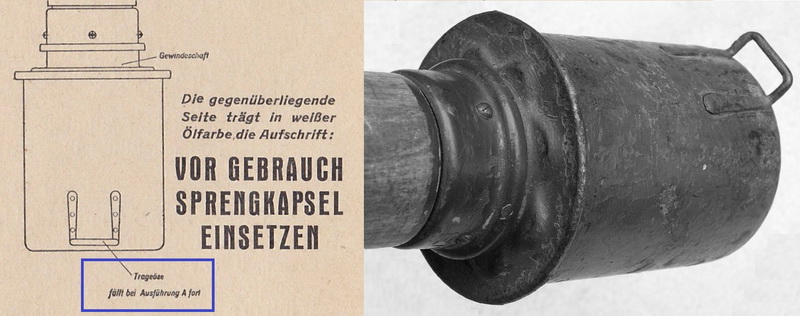 In "Waffentechnische Unterrichtsbuch" by Schmitt, the Trageösen was still part of the drawings of the grenade, but the text states that "Trageösen fällt bei Ausführung A fort" (Carrying eyelets will be discontinued with the A version). This is the only reference to separate "models" I have ever found in the original documentation from the era.  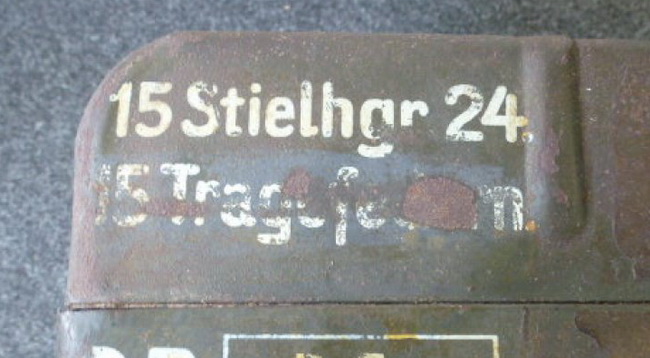 It is no longer known what the "Tragefeder" looked like. The manual mentioned above also states that 15 Tragefedern were included in the transport box (but that these would be discontinued as well). 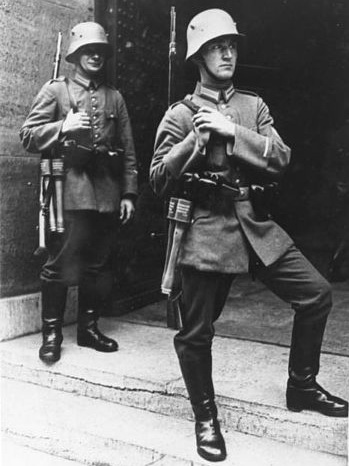 The above picture from 1 July 1932 shows two Reichswehr soldiers guarding the Reichswehrministerium in Berlin. They are both armed with Mauser rifles and two Stielhandgranate 24. The Trageöse and Tragefeder are clearly in use, even though details of the arrangement can't be studied. In the Heeres-Verordnungsblatt Nr. 10 from 5 April 1933 it was announced that the Trageösen and Tragefeder would be discontinued altogether. 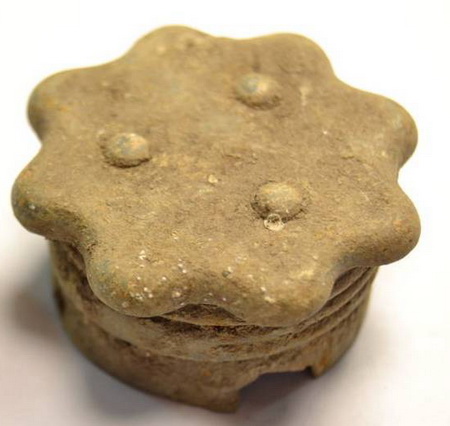 A ground dug safety cap from a WW1 Stielhandgranate 15. It had a star shaped plate riveted to the bottom with 2, 3 or 4 rivets.  The Ausführung A had a safety cap that was similar to the ones used on the Stielhandgranate 15, as it was star shaped. But on the Stielhandgranate 24 this was done by simply shaping the upper edge of the cap. These caps are often wrongly identified as a special "winter-model" to ease the unscrewing with mittens on. The pre-war WaA found on these (picture above left) should have been a dead give-away though. The first version with the Trageöse stayed in production from 1924 to 1933. The second version  The second version was made without the Trageöse, and was manufactured from 1933 until 1944. It evolved during the whole period with simplifications to the production both to save laboring time and materials, but the main design remained unchanged. The star shaped safety cap was used on the second version from the start of production in 1933, but seems to have been discontinued around the mid 1930's and gave way to the standard smooth safety cap. 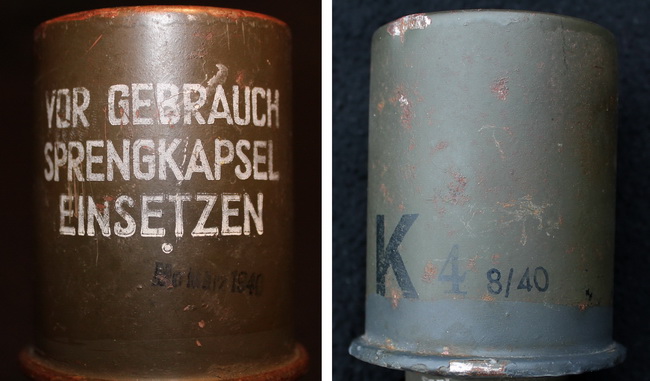 The next simplification came in April 1940, when it was decided to discontinue the painting of the white text "VOR GEBRAUCH SPRENGSKAPSEL EINSETZEN" on the heads. All Stielhandgranate 24 manufactured prior to this date should have the text applied to the head. The next to disappear was the painted band applied to the lower part of the head along the crimped edge for weatherproofing. This was discontinued sometime around 1941-42.  Then another production simplification was introduced. From 1942 the raincap was no longer attached with 4 small screws and it was no longer painted "in position" for added weatherproofing. Instead of the screws, 4 triangular cuts were pressed into the raincap when it had been mounted on the handle, thus attaching both the raincap and the threaded cap to the handle in a cost-effective and efficient way. 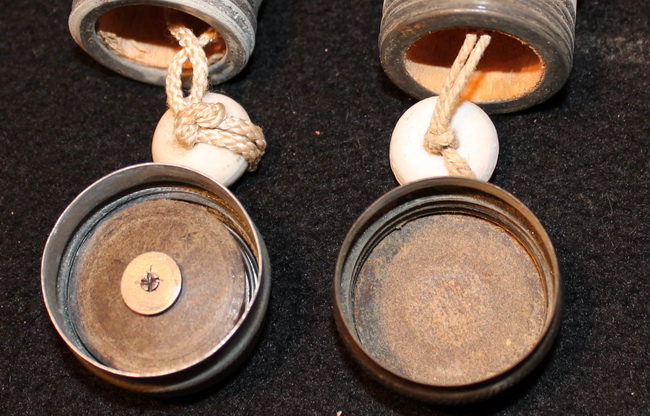 In 1943 the safety cap was simplified. The spring and cardboard disc was replaced with a simple cardboard disc. This one no longer added any pressure to the porcelain ball, it simply sealed off the end and weather-proofed it. The second version is by far the most common found today. It was manufactured well into 1944 until it was replaced directly by the Stielhandgranate 43 by most manufacturers. The third version  The last production improvement was introduced in 1943, but has only, with one exception, been observed on Stielhandgranaten 24 made by Metallwarenfabrik Hermann Nier, Beierfeld, with the code fcc. My initial conclusion was that the third version must have been a manufacturers improvement to speed up production, but the latest discovery by Nick Jeans in the UK of a eyu marked handle with pressed threads strongly suggests that this was a version change initiated by the Waffen Amt. Se the "Makers of the Stielhandgranate 24" section for more details about the manufacturers. 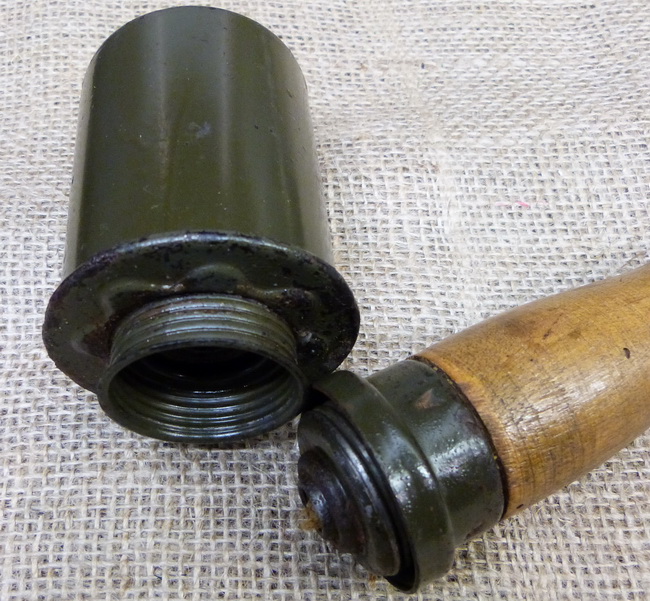 (Picture courtesy of Nick Jeans) The design of the screw attachment between the handle and the head was simplified with pressed threads instead of the more time-consuming machined threads. The lower edge of the threaded part of the can was pressed out into a flange that would sit against the oil soaked cardboard ring between the threaded cap and the raincoat. The raincoat on this version has a easily recognizable wider upper band. This late variation was only manufactured in numbers by one manufacturer (fcc), but it can be found made by at least one more manufacturer. It is distinctly different from the standard production version (second version) and qualifies as the "third version" of the Stielhandgranate 24. The color used on the metal parts of the Stielhandgranate by all manufacturers was ordnance green for the whole production time from 1924 to 1944, with one exception.  Again it was the company of Metallwarenfabrik Hermann Nier, Beierfeld (fcc). Their last batch of Stielhandgranaten 24 with pressed threads of the third version was painted in the Dunkelgelb ordnance color. This is also a clear indicator that they were the last manufacturer of the Stielhandgranate 24. The third version was introduced for production around the same time that the Stielhandgranate 43 production plans must have been ready. As a result the version saw very limited production. Most manufacturers switched directly from the second version to the Stielhandgranate 43. Manufacturing differences 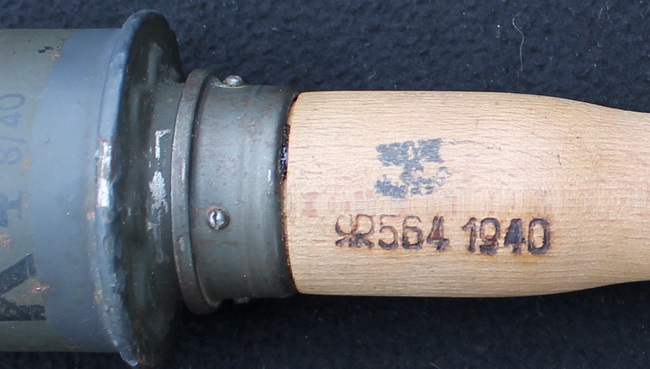 The finish on the individual parts deteriorated through the whole production period, and was different from one manufacturer to another. The raincap is one example. During the war-production it was no longer painted after installation for added weatherproofing, but painted during production prior to assembly. Some manufacturers stopped painting it already in 1940 using phosphating instead (see picture above), while other manufacturers kept on painting them until the end. Some manufacturers used linseed oil on the wood until the end of production, while others discontinued this practice already in 1940. The differences between the different manufacturers were endless. For further details see the section about each individual manufacturer. The myths about the different models of the Stielhandgranate 24 The Stielhandgranate 24 came in 3 different "versions". The first version with the Trageöse (1924-1933), the second version that was the standardized model (1933-1944) and the third version with pressed threads that were only manufactured in numbers by Metallwarenfabrik Hermann Nier, Beierfeld (1943 to 1944). The third version of the Stielhandgranate 24 is sometimes referred to as a "M42" by collectors, but the designation "M42" is pure collector-fantasy, a designation like that was never used by the Wehrmacht. The Wehrmacht only had one "model" of the Stielhandgranate 24. Any other model designation is postwar created by collectors to better describe the different variations. The official german designation was "Stielhandgranate 24" and sometimes the shorter "Handgranate 24". The designation "Model 24" or "M24" derives from the description "Stick Hand Grenade Model 24" that was used in the publication "German Infantry Weapons", prepared by Military intelligence service, dated May 25 1943. It is a translation to english, and not a german used designation. They never used the designations "Model 24" or "M24". The "Stielhandgranate 39" is also pure fantasy, but this "fantasy model" can actually be traced back to its origin. Once again it is the contemporary Allied intelligence publications that are the source of the misunderstanding. The publications were based on reports from the field units, captured materials and manuals. The publication "German Infantry Weapons", prepared by Military intelligence service, dated May 25 1943 accurately describes the Stielhandgranate 24. The illustrations are clearly copied from the "Waffentechnische Unterrichtsbuch". But then a new grenade is born, the "Stielhandgranate PH 39". This description appears to be a Stielhandgranate 24 as well, but with some added features from the Eierhandgranate 39 ("pull cord attached to the metal cap"). The letters "PH" in the model designation is unexplainable.  I have the corresponding pages from the manual available as a PDF in the manual section. The overall length of the grenade is increased with 2 inches, the weight is 1 ounce more explosives, and the effective blast radius increased from 14 yards to 16 yards. Another publication, The Recognition handbook for German ammunition, dated April 1945 and published by SHAEF only describes the Stielhandgranate 24 and 43. But the "Stielhandgranate 39" re-appears again in the 1953 dated publication "German Explosive Ordnance" from the US Army. This manual drops the "PH" in the model name, and states that the Stielhandgranaten 24 and 39 "are similar in all characteristics except size". 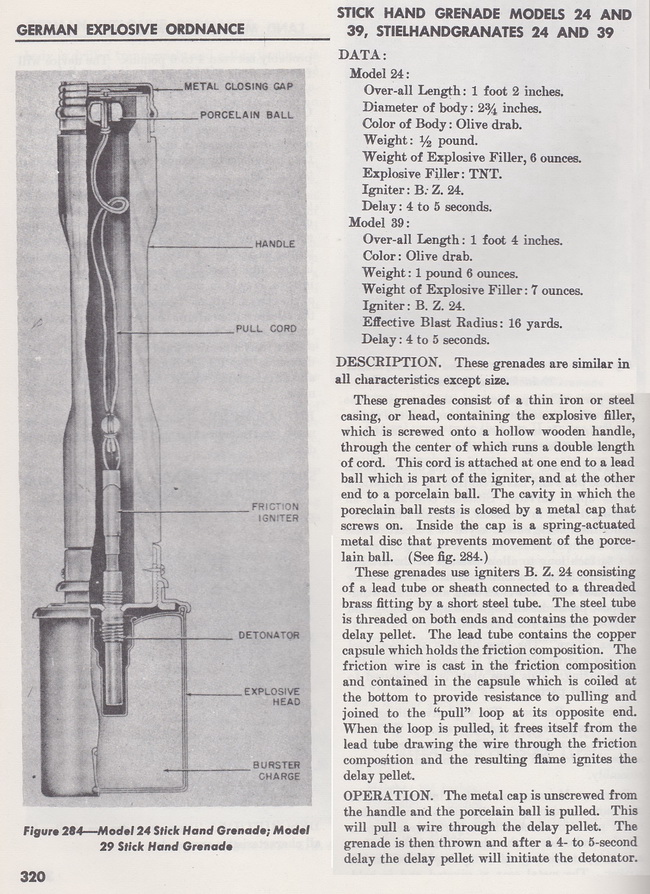 The contemporary German publications never mention any other model but the Stielhandgranate 24 and 43. Go back to the Stielhandgranate 24 menu |
| Home | For sale | Site map | Contact information | Guest book | Stielhandgranate 24 menu |